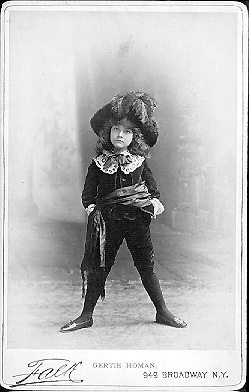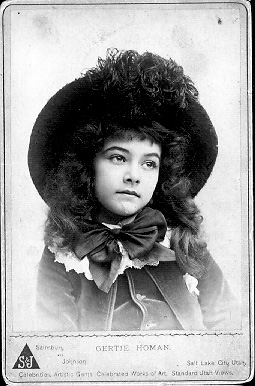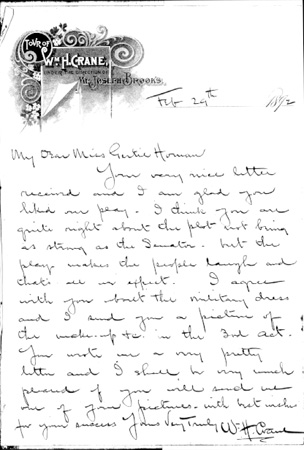 Volume I: Narrative History
Volume I: Narrative History Volume I: Narrative History
Volume I: Narrative History
Gertrude F. Homan was born in New Orleans, Louisiana on April 23, 1882, the daughter of George and Louise Homan. Note When she was four years old her parents moved north, where they settled in Brooklyn, New York. By the age of six she was on the stage in Partners, at the Madison Square Theatre in New York City. On April 25, 1888 the players in that production presented her with a leatherbound scrapbook, which she used for the next decade to collect autographs and display letters she received. Many friends and fellow players wrote sentiments to her.
On April 25, 1888, May Robson expressed the hope "May your understudy never get a chance to play." On the same date this note was penned in florid script: "Dis ist mein little daughter! 'Partners.' A. Salvini."
The Partners company went to the West Coast in the summer of the same year. An article in The Daily Alta California, August 10, 1888, relates: "The overland train that arrived shortly before 6 o'clock last evening brought to San Francisco the Palmer Dramatic Company, which is to open a season of five weeks at the Baldwin Theatre on Monday in their latest great success, Partners. With a few exceptions, the company is composed of the same talented artists who played such a successful engagement here two years ago....
The Palmer Company, as now organized, is composed of the following ladies and gentlemen: J.H. Stoddard, Fred Robinson, Louis Massen, E.M. Holland, Walden Ramsey, C.P. Flockton, Herbert Millward, Harry Holliday, George S. Stevens, Mrs. E.J. Phillips, Marie Burroughs, Annie Russell, May Brooklyn, Virginia Buchanan, Clara Lipman, Kate Molony, Annie Homan, Little Gertie Homan, J.B. Hollis, and G.W. Presby.
The party left New York a week ago last Monday, and made the run with a stoppage of two days only in Chicago. From there they came through without a change of cars to Oakland.... Mr. Palmer said, "Our people have had a rest of over two months, and many of them have taken a run across the Atlantic during the vacation, and now return to work invigorated by the rest and change and with renewed ambition."
"I am told," said the reporter, "that you have a remarkable little lady in Gertie Homan; is that so?" "Indeed we have," said Mr. Palmer, enthusiastically. "She is a wonderful little woman - yes, little woman - for six years of age. We found her very entertaining on our trip, and she was the life of the party. You will see her in Partners."
Little Gertie Homan's scrapbook continued to acquire entries. While in San Francisco on September 15, 1888, she acquired this sentiment from Julia Robison: "Go on as you have begun - Sweet Little Star Light." A few weeks later on the return trip from the West Coast, in Denver on October 3, 1888, Henry M. Woodruff wrote: "There is a pretty little flower; Of sky-blue tint and white; That glitters in the sunshine; And goes to sleep at night; 'Tis a token of remembrance; And a pretty name it's got; Would you know it if I told you?; 'Tis the sweet forget-me-not."
On June 11, 1889 William Robert Pike inscribed a scrapbook page: "There came to us a little blossom - sparkling with dew from God's own kingdom - Gertrude!" Around the same time, Etienne Girardotm Note wrote: "She's as sweet as a ripe strawberry - picked early in the morning with the dew on!" On September 14, 1889 Augustus Cook whimsically wrote: "The more I see of men, the more I love dogs. But you are sweet-sweet always."
In an interview in 1930, Note Gertrude Homan Thanhouser recalled an incident from her childhood: "'Rather a curious coincidence that I should have been the first child to sing for Mr. Edison when he was making his experiments with the phonograph. I sang into a wax cylinder, in his Twenty Third Street studio, the lullaby that Editha lisps to the cracksman in the second act of The Burglar. That was in 1888. I was seven, and the inventor was 41.' Edison was presented to the former Editha and recalled the incident perfectly."
An unattributed news clipping from late in the month of December 1890, saved by Gertrude's parents, told of her activities at the time:
One of the happiest young ladies in this town yesterday was Miss Gertie Homan, the charming little Brooklyn actress who plays the part of Mignon in Bootles' Baby. Her Christmas was one of the merriest. The members of the company, which is this week at the Amphion, and her many friends and admirers had fairly showered presents upon her, and from early morning until her eyes closed in slumber last night, she was the gayest of gay.
Gertie Homan is only eight years old, but she has been on the stage nearly two years. In that time she has developed a dramatic power which amazes all who see her. The best judges of acting in the country have spoken in the highest terms of her and predict for her a brilliant future. She is a beautiful little rose of the South transplanted to a Brooklyn home, with dark liquid eyes, capable of expressing any emotion, and a wealth of black hair that falls over her shoulder in wavy ringlets. Her elocution is excellent, and her power of facial expression something worth traveling miles to see.
She has played several parts in her brief career and all of them well. Her Little Lord Fauntleroy is believed to be as fine an impersonation of the character as has yet been seen, and as Editha, in The Burglar, she has won golden opinions. Gertie is a member of the Madison Square Company and has traveled all over the country with her parents. Her parents are Creoles and formerly lived on the Gulf Coast. They were near neighbors of Jefferson Davis, their home, Sea View, Note being separated from Beauvoir [Davis' estate near Biloxi, Mississippi] by only one other residence. Gertie is the youngest of ten children. Her father disposed of his property in the South a few years ago, and, bringing his family north, settled in Brooklyn. Here he found a large Southern colony and many friends. The family resides at 452 Wythe Avenue, and it was there that Gertie enjoyed her Christmas....


Gertrude Homan as Little Lord Fauntleroy ca. 1890. Courtesy Thanhouser Family Archives (X-290-1, X-290-2)
Another undated, unattributed clipping from the era gives a review of Gertrude F. Homan as Little Lord Fauntleroy in the play of the same title: "Little Lord Fauntleroy was presented to an appreciative audience at Ming's last night. The story is an interesting one and is nicely dramatized. The fact that the leading role is assumed by so young a character makes the play the more interesting. Miss Gertie Homan played the part of Cedric Errol, Lord Fauntleroy, in a most pleasing manner. She won the admiration of the audience from the start. Her acting is so graceful and her style so charming. Much could be said of this little actress that could hardly be said of many older ones now playing as stars. Frank E. Aiken, as the Earl of Dorrincourt, presents a splendid portraiture of the gouty and irascible English nobleman...."
A further unattributed clipping notes: "The Burglar at the Madison Square Theatre Note has made so popular a success that the chances are that it will run through the summer's heated term with good financial results. Gus Thomas, author of the play, has every reason to feel proud of the success his work has made.... On Fourth of July night the receipts were the greatest in the history of the house as compared to those of other 'Fourths.' Mr. Barrymore, Note as the burglar, gives us another of the strongly drawn characters of which his Capt. Swift is a good illustration.... One of the chief attractions of the piece, however, is the wonderful performance of little Gertie Homan as Editha, and so great is her success that she has been re-engaged for the coming season. Sydney Drew, who made a hit as the young lawyer, has also been re-engaged. There is no doubt of The Burglar's future."
In April 1892 she was on the stage in New York City, where at Palmer's Theatre Pygmalion and Galatea was presented for the benefit of the Actors' Fund. Gertie Homan took the part of Myrine, Pygmalion's sister. An unattributed New York City newspaper clipping, dated April 27th, preserved by Miss Homan's parents, told of Gertie's performance:
The most artistic piece of acting in the play was done by little Gertie Homan, an actress to the tips of her fingers. Hers was the soubrette part (Myrine), and she played it as Bernhardt would have - unwillingly, but divinely. The dark olive face and sparkling eyes of this beautiful little Creole alone would attract universal attention, but the graceful poses into which she seemed to dissolve, and the earnestness with which she spoke her tender, loving lines charmed the coldest heart, and made the most ardent supporters of the Society for the Prevention of Cruelty to Children feel happy that its power has been circumscribed.... Note
The strongest scene in the play was the climax of the last act, when Myrine brings blind Pygmalion to Galatea. The three children made a beautiful tableau which was encored again and again by a large audience, composed mostly of children. The applause was continuous and deserved throughout the play, and it was evident that the public welcomed the return of juvenile performances. The curtain went down, the audience lingeringly departed and the lights were turned low. But the children on the stage? Tired? Not a bit. As the orchestra struck up a lively waltz, they joined hands and danced about. Myrine, still robed in her pure Greek robes, stood in the center - an ancient goddess in miniature, smiling and happy, for it was her tenth birthday, and still within the portals of Pygmalion's studio, Gertie's youthful contemporaries decided to celebrate the occasion fittingly. Tommy Russell [who played the part of Pygmalion] presented an exquisite basket of Jacque roses, and the others followed suit with various floral tributes until the little goddess was almost hidden behind a perfumed wall.
Gertie Homan was born in New Orleans ten years ago, but moved to Brooklyn at the age of four. A.M. Palmer Note saw her at Sunday school and offered her the child's part in Partners, which she played so well that he commissioned Gus Thomas to write The Burglar for his little protegée, and at the age of six Gertie became a full-fledged star.

Letter from stage star William H. Crane to Gertrude Homan, February 9, 1892.
This and other momentos were saved in a leather bound blank book used for remembrances from others on the stage. (M-37)
During the 1890s she played roles in The Burglar (which was retitled Editha's Burglar), Bootles' Baby, Romeo and Juliet (as Juliet, in 1892), The Childhood of Jack Harkaway, Note and many other productions. Her greatest renown was achieved with her renditions of Editha and Little Lord Fauntleroy. Note
Copyright © 1995 Q. David Bowers. All Rights Reserved.